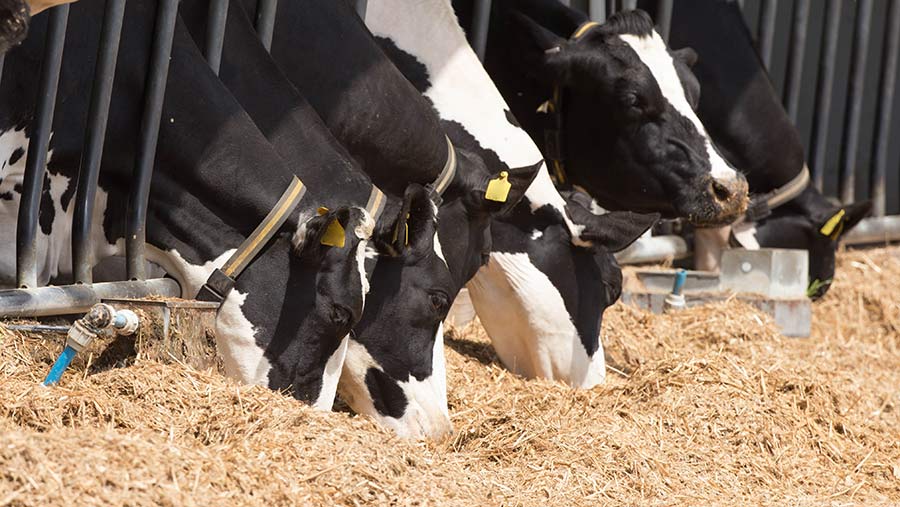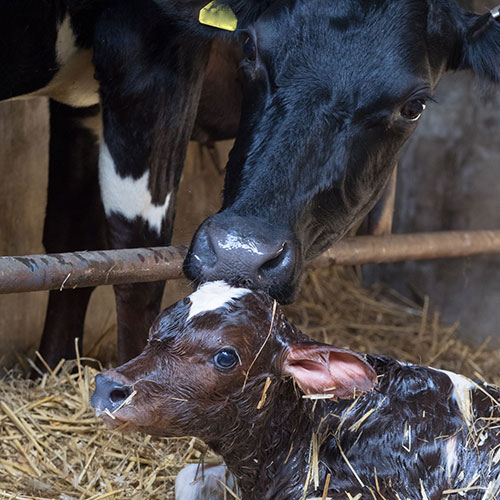How to assess if your dry cow ration is working effectively
 © Tim Scrivener
© Tim Scrivener The success of early lactation performance, metabolic disorders, udder health and fertility are all linked to the diet fed during the dry period.
Although a ration may look adequate on paper, it is important to check it is the diet being consumed.
Feed sorting, for example, will affect nutrient intake. Therefore, regular checks are necessary both in the dry period, at calving and post-calving to ensure the diet is doing its job.
Sean Hughes from Shropshire Farm Vets gives advice on how to assess whether your dry cow ration is working effectively.
See also: 5 key considerations when feeding minerals to dairy cows
Monitor intakes
Why it matters
The primary aim of dry cow feeding is to maintain body condition, maximise mammary development and prime the immune system.
How to assess it, and targets
The target daily intakes for Holstein cattle in the close-up dry period should be 12-14kg of dry matter (DM).
It is hard to assess individual intakes, so this needs to be assessed on a group basis. It may be time consuming to weigh feed in and out, but it can tell you a lot about whether your cows are eating enough, if they are sorting food and getting the correct dietary balance.
You can also sieve the leftover ration which can tell you if chop length it is correct.
Troubleshooting problems
Feed intake can be affected by:
- Inadequate feed space: In a straight-rail feeding system 1m a cow is the minimum. In locking yokes or a herringbone feed rail, two spaces are required a cow or 60cm a cow. Less space is required in these systems as you get fewer issues with dominant cows pushing out the subordinate animals.
- Palatability: Anionic salts in the feed, although essential, can make it unpalatable. If you are including brewer’s grains/moist feed to improve palatability and lower the Dietary Cation Anion Balance (DCAB), care must be taken to make sure it is balanced. Molasses has a high DCAB, which isn’t what you want in the dry period as it can predispose cows to milk fever. Fusty straw can also affect palatability. If the diet is heating up this can affect palatability and cause gut upset.
- Chop length: If you are left with lots of long bits of straw and sorting, then your chop is too long. The ideal length is 10-30mm.
- Over-condition cows: Addressing body condition issues should be done in lactation. Body condition scoring (BCS) different lactation and dry cow groups regularly will help avoid these issues.
Carry out rumen fill scores
Why it matters
Rumen fill scores are a good indication of nutritional status of the animal.
See also: Video guide to carrying out rumen fill scores
It quantifies the intake of feed and its rate of passage of feed over the previous few hours.
How to assess, and targets
Cows can be scored at any time of the day. However, it’s best to score at random times to give you an overall impression of rumen fill throughout the day. The ideal score varies for different breeds, however dry cows should score either 4 or 5 (see below).
Ideally, rumen fill scores should be conducted after a change in the diet. This may not mean a change of ingredients, but rather a change in the silage clamp being used, or batch of straw, for example.
What do the scores mean?
Score 4= The skin under the lumbar vertebrae curves outwards. No para lumber fossa is visible behind the last rib.
Score 5= The lumbar vertebrae are not visible as the rumen is well filled. The skin over the whole belly is quite tight. There is no visible transition between the flank and ribs.
Troubleshooting problems
See troubleshooting problems associated with intakes above.
Assess dung scores
Why it matters
A rumen audit can help assess whether a diet is working efficiently in order to maximise production and avoid health issues.
See also: How to carry out cow muck assessments
How to assess, and targets
- Take 10 representative samples of manure. Each sample should be collected in plastic cups that are labelled 1-10.
- Look at the consistency of the manure and score it on a scale of 1-5; 1 being like soup/water and 5 being dry and high in undigested fibre. The ideal is a score of 2-3 in lactation.
- Look at the manure and see if there are any gas bubbles. If there is any bubbling, then it is a sign of acidosis.
- All samples should be weighed individually before they are washed through in a manure sieve. Wash through the manure until the water coming out the bottom of the sieve runs clear. During washing, look for foaming. This is a sign of the acid load.
- Assess the washed manure. Look out for balls that look like clay. If you find any, then this is a sign of poor rumen function.
- Watch out for mucin casts, which look like sausage cases. Too much acid loading can damage the gut lining. Mucin casts are produced to cover the damage and are then shed out.
- Ideally there should be no grain in the sample. If there is it’s not being digested. This could be because the rumen is not working efficiently enough to digest all the grain or it could be that it hasn’t been cracked properly, enabling digestion.
- You also need to look for other undigested material in each sample. If a cup is more than 25% full of undigested material after washing it means the rumen is not using what is being fed to the cows.
Troubleshooting problems
If a problem is found it is most likely diet related. If the starch is too high in the diet, this can cause acid loading.
Blood test and metabolic profile cows pre- and post-calving
Why it matters
Blood tests taken in the dry period and post calving can tell you a lot about the energy, protein and mineral status of an animal and will give you an overall picture at a herd level.
How to assess, and targets
- Pre-calving blood tests for non-esterified fatty acids (NEFAS) give you an indication of how much fat is being broken down. A high NEFA level in the blood indicates intakes are not sufficient and the cow’s energy requirements are not being met as she is breaking down her fat reserves. Breaking down fat also puts pressure on the liver.
- Blood mineral analysis will give you an indication of the essential minerals – calcium, phosphorus and magnesium. If they are low, then you need to look at the ration and make sure it is providing the correct level of minerals.
- Testing for selenium gives you an indication of an animal’s immune status. If they have low levels of selenium and vitamin E, then their immune function may be impaired.
- Ketone tests (see buyer’s guide) measure the beta-hydroxybutyrate (BHBA) levels in the blood. This is the most predominant ketone in the cow’s blood and is known to be the gold standard for diagnosis of ketosis. These tests are usually taken post-calving (after day four). Subclinical ketosis is considered when ketone levels reach between 1.2mmol/L and 2.9mmol/L. This is an important threshold to detect advancing cases of ketosis.
- Urea and albumin levels give an indication of short- and long-term protein status.
Troubleshooting problems
If the mineral status isn’t correct, go back to the drawing board and look at the diet’s mineral availability from forages and additional ingredients.
Ketosis occurs in cattle when energy demands (e.g. high milk production) exceed energy intake and result in a negative energy balance. Ketotic cows often have low blood glucose (blood sugar) concentrations.
If you are getting high levels of ketones in blood tests or ketotic cows, then you need to address the energy availability or intakes in either the dry cow ration or fresh cow ration.
See troubleshooting problems associated with intakes for more detail.
Record problems at calving

© Kathy Horniblow
Why it matters
Noting down any issues that occur at or around calving will help you quantify if there are any problems.
Clinical milk fever is one of the biggest issues at calving and is associated with the ration in the dry period.
Other conditions affected by the transition diet include dystocia (calving difficulties), retained foetal membranes, metritis, ketosis, left displaced abomasum and mastitis.
How to assess, and targets
Regularly check your records to see if there are any trends and that your levels are not exceeding the targets. Targets are:
- Milk fever: <3%
- Retained foetal membranes (RFM)– failure to expel the placenta within 12 hours of calving: <8%
- Metritis inflammation of the uterus (uterine cavity and entire uterine wall) and is generally caused by bacterial infection: <10-15%
- Sub-clinical ketosis: <15%
- Left displaced abomasum (LDA): <2%
- Mastitis: <25 cases every 100 cows or 1 case in 12 cows of dry period origin and two cases in 12 cows of lactation origin.
Troubleshooting problems
Milk fever: The transition diet should prime the cow ready for calving. If the DCAB is too high (positive) it can affect calcium metabolism from the bones.
By adding anionic salts such as magnesium chloride to the dry cow ration you acidify the blood, making calcium more readily available at the point of calving.
The other issues can also be diet linked. If a cow is in negative energy balance at calving and calcium levels are low, then her immune system will struggle, predisposing her to the conditions mentioned above.
Check colostrum quality

Using a refractometer to assess cattle performance © Billypix
Why it matters
More than half of calf deaths occur with the first six weeks of life and can often be associated with poor colostrum quality and intake as well as disease.
See also: Rethinking cattle performance video: How to use a refractometer to test colostrum quality
How to assess, and targets
The target is <3% calf mortality. Good record-keeping is essential to monitor this at a herd level.
It’s important to assess colostrum quality, this can be done by using a Brix refractometer. High-quality colostrum can be defined as having at least 50g/L IgG with a reading above 22% on a refractometer.
You can also take bloods from calves within the first days of life to assess the absorption of antibodies from the colostrum.
Troubleshooting problems
The process of colostrum production begins several weeks before calving. During this time, large amounts of immunoglobulins (IgG) (antibodies) are transferred from the bloodstream of the cow into colostrum.
Mineral and nutrient status during the dry period will influence colostrum quality. Assessing colostrum quality and passive transfer will highlight potential transition issues.
Stress and disease can also affect colostrum production. It is important dry cows remain in stable groups, as changing the social environment throughout the dry period can impact intakes and increase stress.
